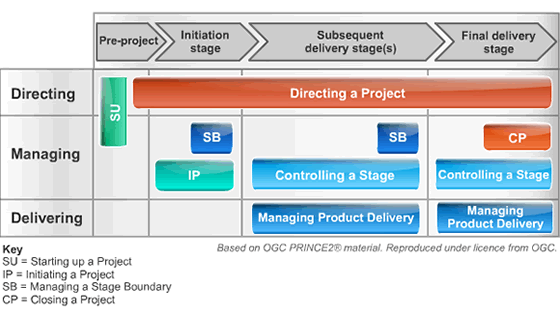The PRINCE2® processes explained
PRINCE2® is a process-based approach for project management providing an easily tailored, and scalable method for the management of all types of projects. The methodology details seven processes, which provides a structure for all project managers to follow.
PRINCE2 processes
Starting up a project
This is the first process in PRINCE2. It is a pre-project process, designed to ensure that the prerequisites for initiating a project are in place. The process expects the existence of a project mandate which defines in high level terms the reason for the project and what outcome is sought from it.
The work involved in the ‘starting up a project’ process is built around the production of three elements:
- Ensuring the information required for the project team is available
- Designing and appointing the project team
- Creating the initiation stage plan
Directing a project
Directing a project runs from the start of a project until its closure. This process is aimed at the project board, who manages and monitors the project via reports and controls at a number of decision points.
The role of the project board falls into four main areas:
- Initiation (starting the project off on the right foot)
- Stage boundaries (commitment of more resources after checking results so far)
- Ad hoc direction (monitoring progress, providing advice and guidance, reacting to exceptional situations)
- Project closure (confirming the project outcome and controlled closure)
Initiating a project
The objectives of initiating a project are to:
- Agree whether or not there is sufficient justification to proceed with the project
- Establish a stable management basis on which to proceed
- Document and confirm that an acceptable business case exists for the project
- Ensure all required resources are available for the first stage of the project
- Enable and encourage the project board to take ownership of the project
- Detail the decision-making process to be used throughout the project lifecycle
- Ensure that the investment of time and effort required by the project is made wisely, taking account of the risks to the project
Controlling a stage
This process details the work required by a project manager to ensure that each project stage remains within the tolerances laid out by the project board.
This process highlights that during each stage there should be a cycle consisting of:
- Assigning work
- Gathering information on team progress
- Monitoring risks
- Reviewing the situation
- Reporting to the project board
- Taking any necessary corrective action
Managing product delivery
The objective of this process is to ensure that planned products are created and delivered by:
- Making sure all project team members are aware of their role in the product delivery
- Ensuring that work conforms to the requirements identified in the work package
- Ensuring that the work is done, on time and on budget
- Assessing work progress and forecasts regularly
- Ensuring that completed products meet quality criteria
- Obtaining approval for the completed products
Managing a stage boundary
This process provides the project board with key points at which they can decide whether to continue with the project or not.
The objectives of the process are to:
- Assure the project board that all deliverables planned in the current stage plan have been completed as defined
- Provide the information needed for the project board to assess the continuing viability of the project
- Provide the project board with the information needed to approve the current stage’s completion and authorise the start of the next stage, together with its delegated tolerance level
- Record any lessons or reflections which can help later stages of the project and/or other projects
When combined with risk management and change control activity, this process should make up the majority of a project manager's day-to-day role.
Closing a project
The purpose of this process is to bring the project to an end in a controlled manner. The objectives of this process are:
- Check the extent to which the objectives or aims laid out in the project initiation document (PID) have been met
- Confirm the customer or end user is happy with the project output
- Obtain formal acceptance of the deliverables
- Confirm to what extent all expected products have been handed over and accepted by the customer
- Confirm that maintenance and operation arrangements are in place where needed
- Make recommendations for follow-on actions
- Capture lessons learnt from the project
- Prepare an end project report
- Notify the organisation of the intention to disband the project team and re-allocate resources
Use this diagram to help familiarise yourself with the PRINCE2 processes and where they fall within a standard project timeline.

Visit our downloads centre to access a wealth of other useful resources.
PRINCE2 training
If you require PRINCE2 training there are two qualification levels to be aware of:
- PRINCE2 Foundation - This entry-level certification will teach you the basics of the PRINCE2 methodology and its key terminology
- PRINCE2 Practitioner - This higher-level qualification is suitable for those with the need to manage projects in a PRINCE2 environment. You must have passed the PRINCE2 Foundation exam before completing the Practitioner course
Learn more about our PRINCE2 training or get in touch with our team to book your course.
Training Quotation
Download Centre









